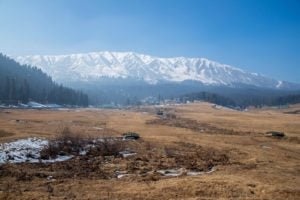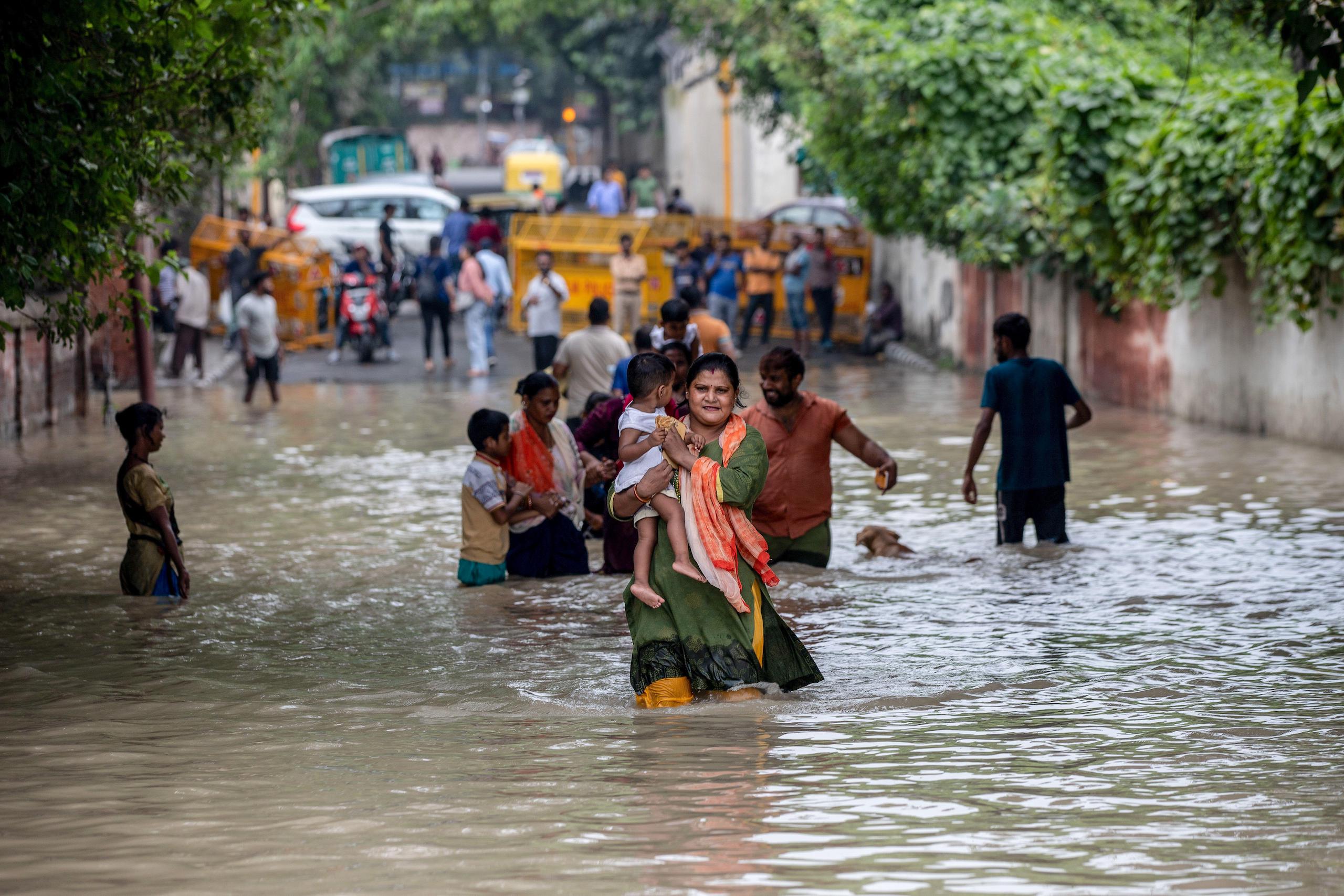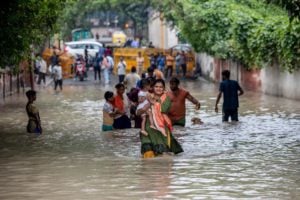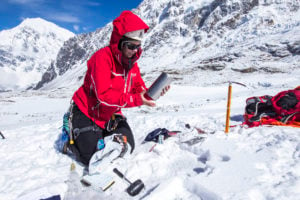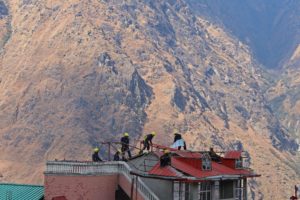Vikram Katoch is visibly worried: the vast valley of Lahaul-Spiti in the northern Indian state of Himachal Pradesh is almost snowless this January. “By now we should have had at least four to five feet of snow, but right now we have nothing,” he says. “It is a matter of grave concern because snowfall ensures our water security and provides water for irrigation and farming to local villagers.”
Katoch is vice president of the Save Lahaul Spiti Society, a non-profit organisation trying to protect this ecologically fragile valley from environmental degradation and the impacts of climate change.
Over 500km north, the situation is no different in the skiing destination of Gulmarg, Kashmir. Despite the ongoing Chillai Kalan (Kashmir’s harshest, 40-day winter period) snow is missing from Gulmarg’s slopes.
Via social media on 9 January, Omar Abdullah, the vice president of the Jammu Kashmir National Conference party, said: “I’ve never seen Gulmarg so dry in the winter … If we don’t get snow soon the summer is going to be miserable.”
On 10 January, the India Meteorological Department (IMD) meteorologist Sonam Lotus confirmed large winter snowfall deficits across the northern regions of Ladakh, Jammu & Kashmir, Himachal Pradesh and Uttarakhand. He added there is no likelihood of snow until 25 January.
Where is the western disturbance?
A western disturbance (WD) is an extratropical storm that originates in the Mediterranean region. An area of reduced air pressure, this disturbance carries moisture from the Mediterranean and Caspian seas east, via the subtropical westerly jet stream. This brings rain and snow to Pakistan and northern India, which replenishes glaciers. These disturbances are therefore crucial for the region’s water security, farming and tourism.
According to Madhavan Rajeevan, a former secretary of India’s earth sciences ministry, both the intensity and frequency of western disturbances are decreasing: “The recent studies very clearly suggest that there is a decreasing trend in winter snow or winter precipitation over the region. This is related to the less-frequent passage of western disturbances.
“The most important worry should be the future projections of WDs. Climate models suggest a further decrease of about 10-15% in the frequency of WDs by 2050 or so. It should really worry us.”
The July 2023 study, “The decline in western disturbance activity over northern India in recent decades”, assessed 39 WD seasons between 1980 and 2019. It reported a declining trend in the frequency of these storms.
According to the report: “The combined mean frequency of strong and extreme WDs declined by as much as ~ 43%, contrary to the mean occurrences of feeble and moderate WDs, which rose by ~ 11% … The sharpest decline (~ 49%) was observed for the most intense WDs (strong and extreme), primarily explaining the decreasing WD precipitation intensity across the core WD zone.”
Similarly, a 2019 WD study published by the American Meteorological Society concluded that: “The decline in WD frequency and intensity will cause a decrease in mean winter rainfall over Pakistan and northern India amounting to about 15% of the mean.”
“WDs are associated with the mid-latitude jet stream – strong westerly winds at around 12-15km,” says Rajeevan. “Observations show this jet stream has moved north during the recent winters. It could be related to global warming (which shows everything moving poleward, including monsoons, tropical cyclones) and also Arctic Sea ice melting.”
Lower winter precipitation, higher summer rainfall
Another disturbing trend linked to WDs is their rising frequency during the months of May, June and July. This trend is noted in the August 2023 preprint of a WD analysis by Kieran Hunt, a meteorology research fellow at the UK’s University of Reading.
According to Hunt’s analysis: “WDs have been twice as common in June in the last 20 years than during the previous 50. This is attributed to delayed northward retreat of the subtropical jet, which historically has occurred before the onset of the summer monsoon.”
The preprint says its most important finding is the significant increase in monsoonal WDs, which means “catastrophic events like the 2013 Uttarakhand floods and the 2023 north India floods are becoming much more frequent.”
Snowless winters
Lotus is based in Leh, Ladakh, where snowless winters are becoming a huge concern. “It is mid-January, which is the peak winter season,” he says. “But it is unusually warm. This winter is the warmest winter in Leh in the past decade.”
According to IMD data, December 2023 was an almost snowless month for most of northern India. Precipitation in both Jammu & Kashmir and Ladakh was -79% of those levels typical in December. In the state of Himachal Pradesh it was -85% and in Uttarakhand it was -75%.
January has so far been worse, with Uttarakhand receiving -99% of the typical precipitation during the first two weeks of this month. Meanwhile, Himachal Pradesh, Jammu & Kashmir, and Ladakh have not received any precipitation.
Snowfall during the winter period is crucial as it feeds the glaciersIrfan Rashid, University of Kashmir
Lotus says this is not the region’s first dry spell: “Analysis of the past 43 years of data shows that there have been years when snowfall has been lower than what has been received this winter.” For example, in 2016 and 2018 Leh did not receive snow during November and December. Gulmarg was similarly dry in 2016: snowfall during November and December amounted to 7.6cms, compared to 23cms in 2023.
Lotus is reluctant to make a direct connection between climate change and this year’s unusual snowfall in the Himalayas. What he deems indisputable, however, is that rising temperatures are making things worse. In 2023, the lowest minimum temperature recorded in Leh was -12.2C, which is significantly warmer than previous years. Lotus says this combination of low snowfall and high temperatures will accelerate Himalayan glacial melt.
Impact on glaciers
The Third Pole speaks to Irfan Rashid, an assistant geoinformatics professor at the University of Kashmir who specialises in Kashmir’s cryosphere. Rashid agrees with Lotus: “In the past two decades, we have had at least four snowless Chillai Kalans. Snowfall during the winter period is crucial as it feeds the glaciers which, during the summer months, slowly release water that rejuvenates springs, feeds the rivers and also provides water for irrigation.”
The term cryosphere refers to the areas of the planet where most of the water is in a frozen form: the polar regions and high mountains. In the Hindu Kush Himalayas, the world’s highest mountain range, frozen water exists in the form of glaciers, ice caps, snow, permafrost, and ice on rivers and lakes.
“People in the valley are already speculating about a drought this year, as it is the winter snowfall that sustains them through the year by providing them water to grow [rice] and apples,” adds Rashid.
The loss of glacier mass is a critical threat to the water security of the Himalayan region. “I have personally been studying the Drang Drung Glacier [in Ladakh] that feeds the Zanskar River,” says Rashid. “It has been receding at a rate of 50m per year since 2017.”
A threat to water security
Rajeevan agrees that the water security of the region could be affected if western disturbances and their associated snowfall decrease: “Water flowing into these rivers [the five rivers of the Indus Basin] due to the melting of snow is very important for water management over this area, for agriculture, power generation.”
He adds that the Indus Water Treaty, which manages river water sharing between India and Pakistan, could also be impacted; Rashid agrees that the lack of winter snowfall and receding glaciers could have a transboundary impact: “We need basin-wide, detailed studies for the same.”
Rashid says these changes also threaten more disasters in the region, such as the Chamoli disaster in February 2021, or the more recent South Lhonak Lake disaster in Sikkim.
“The Himalayan region – not just in India, but the entire Hindu Kush and Karakoram – has steep slopes that host snow or permafrost,” explains Rashid. “These are vulnerable slopes and as heat rises and there is a lack of sufficient snowfall, these areas are likely to become hotspots for disasters such as GLOFs.”
A Glacial Lake Outburst Flood or GLOF is a sudden release of water from a lake formed by meltwater from a mountain glacier, which is held back by ice or a moraine (rocks and sediment carried along by the glacier). These floods can be prompted by an earthquake, avalanche or the accumulation of too much meltwater. GLOFs are often extremely destructive, and are a growing threat in the Himalayan watershed.
Some of these disasters are already evident. Uttarakhand has seen an enormous increase in forest fires, from 922 in 2002, to 41,600 in 2019. Climate change, which increases the chances of low rainfall in this region, is a critical driving factor. Uttarakhand’s forest fires usually happen between April and June, but this year they are already igniting.
Given the scope of these emerging challenges, Rashid believes the Indian government needs to urgently set up a national programme to establish what is happening to western disturbances. He says if they are armed with credible scientific data, institutions can devise plans to handle this looming threat.
